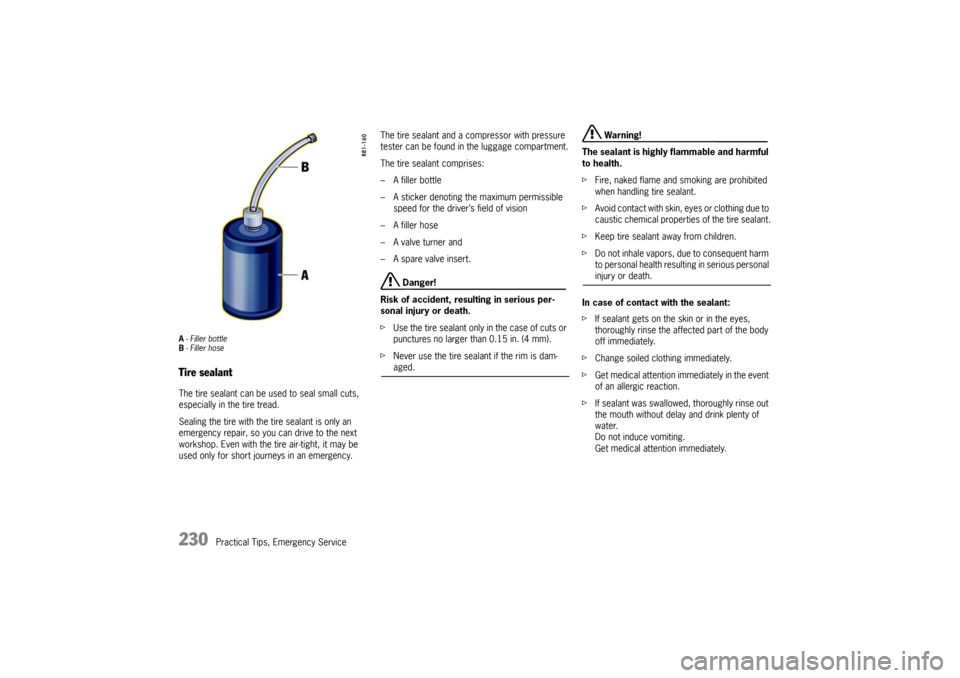Page 220 of 284

218
Practical Tips, Emergency Service
Danger!
Risk of serious personal injury or death.
Driving the vehicle with low tire pressure
increases risk of a tire failure and resulting
loss of control. Furthermore, low tire pres-
sure increases rate of wear of the affected
tires.
f Check tires – including sidewalls – regularly for
foreign bodies, nicks, cuts, cracks and bulges.
f After driving off road, examine tires for signs
of damage such as cuts, tears, bulges or for-
eign objects stuck in the tread. Replace a dam-
aged tire if necessary.
f Cross curb edges slowly and at right angles if
possible.
Avoid driving over steep or sharp curbs.
f In cases of doubt, have the wheel (particularly
the inner side) checked by an authorized Porsche dealer.
Tire replacements If in doubt, contact your Porsche dealer.
Use only tire makes and types approved by
Porsche.
If you do not use a Porsche recommended
replacement tire, make sure that you
purchase your new tires from a reputable tire
dealer and that the dealer complies with all
manufacturers warnings for those tires.
Only tires with the same make and with the
same specification code (e.g. “N0”, “N1”...)
can be mounted.
Before mounting new tires, check with your
Porsche dealer about the current release
status.
Use tires with “ZR” quality standards. There
are currently no standards concerning tire
strength at speeds above 150 mph (240 km/h).
Tires should be replaced no less than on one axle
at the time.
Only tires of the same make and type must be
used. Mixed tires are not permissible.
Initially, new tires do not have their full traction.
You should therefore drive at moderate speeds
during the first 60 - 120 miles (100 - 200 km). If new tires are installed only on one axle, a notice-
able change in handling occurs due to the different
tread depth of the other tires.
This happens especially if only rear tires are re-
placed. However, this condition disappears as the
new tires are broken in.
f
Please adjust your driving style accordingly.
Installation of new tires sh ould only be done by a
qualified tire technician.
Valves
Rubber valve stems must be replaced every time
a tire is replaced.
For metal valves, the installation and replacement
instructions must be observed.
f Use only genuine Porsche metal valves.
f Protect the valve inserts against soiling with
valve caps.
Soiled valve inserts can cause a gradual loss
of air.
f Use only plastic valve caps.
Page 229 of 284

Practical Tips, Emergency Service
227
Changing a wheel
Warning!
Risk of serious personal injury or death. The
car may slip off the jack.
f Make sure that no one is in the vehicle when
jacking up and changing a wheel.
f Always place the car on stable supports if work
has to be carried out under the car.
Risk of damage to the brake discs of the
Porsche Ceramic Composite Brake (PCCB).
f Always screw in both assembly aids when changing a wheel.
Note
The tools required for changing a wheel (e.g. jack,
wheel bolt wrench, assembly aids) are not sup-
plied with the car.
Your authorized Porsche dealer will be pleased to
advise you.
1. Apply the handbrake fully and engage 1st gear or PDK selector-lever position P and remove
the ignition key.
2. Switch on the hazard warning lights if neces- sary.
3. Secure the car against rolling away, e.g. by
means of wedges under the wheels on the op-
posite side.
This is particularly important on slopes. 4. Slightly slacken the whee
l bolts of the wheel to
be changed.
5. Lift the car only at the specified jacking points.
6. Raise the car until the wheel lifts off the ground.
Please see the chapter “LIFTING THE VEHICLE
WITH A LIFTING PLATFORM OR GARAGE LIFT”
on Page 232.
7. Remove 1 or 2 wheel bolts (see respective illustration).
8. Screw in assembly aids instead of the wheel bolts.
Screw in assembly aid for cars without Porsche Ceramic
Composite Brake9. Remove the remaining wheel bolts.
Note on operation
f To remove or mount the spacers:
Please see the chapter “SPACERS” on
Page 233.
Page 232 of 284

230
Practical Tips, Emergency Service
A- Filler bottle
B - Filler hoseTire sealantThe tire sealant can be used to seal small cuts,
especially in the tire tread.
Sealing the tire with the tire sealant is only an
emergency repair, so you can drive to the next
workshop. Even with the tire air-tight, it may be
used only for short journeys in an emergency. The tire sealant and a compressor with pressure
tester can be found in the luggage compartment.
The tire sealant comprises:
– A filler bottle
– A sticker denoting the maximum permissible
speed for the driver’s field of vision
– A filler hose
– A valve turner and
– A spare valve insert.
Danger!
Risk of accident , resulting in serious per-
sonal injury or death.
f Use the tire sealant only in the case of cuts or
punctures no larger than 0.15 in. (4 mm).
f Never use the tire sealant if the rim is dam-aged.
Warning!
The sealant is highly flammable and harmful
to health.
f Fire, naked flame and smoking are prohibited
when handling tire sealant.
f Avoid contact with skin, ey es or clothing due to
caustic chemical properties of the tire sealant.
f Keep tire sealant away from children.
f Do not inhale vapors, due to consequent harm
to personal health resulting in serious personal injury or death.
In case of contact with the sealant:
f If sealant gets on the skin or in the eyes,
thoroughly rinse the affect ed part of the body
off immediately.
f Change soiled clothing immediately.
f Get medical attention immediately in the event
of an allergic reaction.
f If sealant was swallowed, thoroughly rinse out
the mouth without delay an d drink plenty of
water.
Do not induce vomiting.
Get medical attention immediately.
Page 239 of 284
Practical Tips, Emergency Service
237
Replacing fuses In order to prevent damage to the electrical sys-
tem due to short circuits and overloads, the indi-
vidual circuits are protected by fuses.
The fuse box is located in the driver’s footwell.
A - Plastic gripper
B - Spare fuses 1. Switch off the load with the defective fuse.
2. Pull off plastic cover at the finger hole (arrow ).
The fuse plan and instructions for
emergency unlocking of the luggage
compartment lid can be found on the inner
side of the cover.
3. Remove the corresponding fuse from its slot using the plastic gripper A in order to check it.
A blown fuse can be ide ntified by the melted
metal strip. 4. Replace only with fuses of the same rating.
We recommend using genuine Porsche fuses
for replacement.
Note
f If a fuse blows repeatedly consult an author-
ized Porsche dealer.
f Never try to “repair” fuses: you may cause se-
rious damage to other pa rts of the electrical
system.
Page 274 of 284

272
Technical Data
Weights
Dimensions CaymanManual transmissionPorsche Doppelkupplung
Empty weight (depending on equipment) 2932 lbs. to 3153 lbs. 2998 lbs. to 3230 lbs.
1330 kg to 1430 kg 1360 kg to 1465 kg
Maximum gross weight 3605 lbs./1635 kg3682 lbs./1670 kg
Maximum axle load, front* 1731 lbs./785 kg1731 lbs./785 kg
Maximum axle load, rear* 2017 lbs./915 kg2017 lbs./915 kg
Maximum useful load, Roof Transport System** 132 lbs./60 kg132 lbs./60 kg
Cayman S Manual transmissionPorsche Doppelkupplung
Empty weight (depending on equipment) 2976 lbs. to 3175 lbs. 3031 lbs. to 3241 lbs.
1350 kg to 1440 kg 1375 kg to 1470 kg
Maximum gross weight 3627 lbs./1645 kg3693 lbs./1675 kg
Maximum axle load, front* 1731 lbs./785 kg1731 lbs./785 kg
Maximum axle load, rear* 2072 lbs./940 kg2072 lbs./940 kg
Maximum useful load, Roof Transport System** 132 lbs./60 kg132 lbs./60 kg
*The maximum gross weight must not be exceeded. Note: If additional accessories are installed, the useful load will be correspondingly less.
**Use only Original PorscheRoof Transport System
CaymanCayman S
Length 171.1 in./4347 mm
171.1 in./4347 mm
Width 70.9 in./1801 mm
70.9 in./1801 mm
Width with door mirrors 76.9 in./1952 mm
76.9 in./1952 mm
Height 51.3 in./1304 mm, with PASM 50.9 in./1294 mm
51.4 in./1306 mm, with PASM 51.0 in./1296 mm
Wheelbase 95.1 in./2415 mm
95.1 in./2415 mm
Ground clearance 4.5 in./115 mm, with PASM 4.2 in./107 mm
4.4 in./112 mm, with PASM 4.1 in./104 mm
Tu r n i n g c i rc l e 36.4 ft./11.1 m
36.4 ft./11.1 m